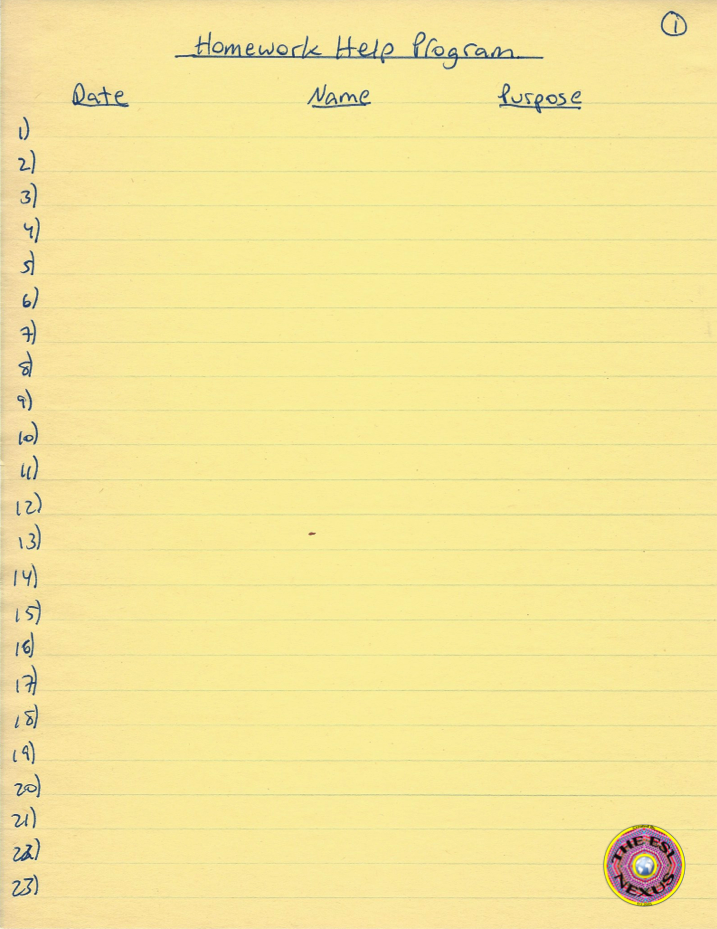If, after doing a needs analysis (as I described in last week’s post), you decide to go ahead and implement a homework help program, below are 10 recommendations that will help make your program a success.
Third, make sure students sign in. They can do that anytime they are in the room but most kids did it on their way out to homeroom when they were finished. I just used a piece of lined, yellow paper—the kind I had my students write first drafts on—and wrote “Date,” “Name” and “Purpose” at the top, then numbered it all the way to the bottom of the page. As soon as that page was filled, I started another one. I also made sure to have a pencil nearby to make it easy for the kids to fill out the form. (Although the pencils kept mysteriously disappearing…) The reason I asked for the purpose was two-fold: a) To keep track of why they were there, so I could analyze their reasons for participating, and b) to get them to think critically about why they were there. That is, I didn’t want them to just write “homework” or even “ELA” – I wanted them to be more specific, especially if they were working on a multi-part project or assignment.
 |
| Form used by students; source: The ESL Nexus |
Fourth, make sure students are quiet! It was often hard to maintain an atmosphere of calmness because my students were naturally exuberant but it is so important that all students be able to concentrate on getting their work done, especially when they have difficulty understanding what to do or are studying for a test. If a student or group of students got too loud and I had to remind them more than twice to keep their voices down, there were consequences: Sometimes I’d warn them they wouldn’t be able to come again if they didn’t change their behavior or I told them I’d be emailing their parents — that usually got them to straighten up right away!
Fifth, if you, the teacher, are busy helping one student and others also need help, see if a classmate or an older student can provide assistance until you are able to check in and see what’s going on. I frequently had to resort to asking other students to help out and most of the time, they were okay with that. In fact, a lot of the time, if students had the same assignment, they’d sit at a table in the back of my room and work. I told them they had to do the work themselves but when they were done they could compare their answers. I kept my eye on that and it worked out pretty well.
Sixth, it’s fine if students need to go to the bathroom but make sure they take a pass. And remind them not to wander the hallways when they are supposed to be in your room. Some of my students would take a long way to the bathroom and stop at their locker but if another teacher found them, they were on their own – I did not provide them an excuse since they were out of bounds.
Seventh, have something available for students to do if they finish their work early and there isn’t enough time to go outside or wherever the other students were yet it also was to early to go to homeroom. I had a huge library of books which a few students would look at; more would play a board game from the pile I had in a cabinet. A few of the boys liked to play catch with one of the squishy balls I kept on hand for ADHD kids to use during class and, as long as it didn’t interfere with anyone else, I allowed them to do that. However, they most definitely were not allowed to throw the yoga balls back and forth! And, yes, some of them tried.
 |
| Two of my squishy balls; source: The ESL Nexus |
Eighth, if you have computers in your room that you have decided students can use, boot them up before they arrive. My computers were old and took forever to warm up so that was the first thing I did after arriving in my room and putting my stuff away. I allowed students to play educational games if they finished their work and I also allowed a few students who didn’t have Internet access at home to use the computers if they didn’t have any homework and just came for that reason. However, it’s really important to keep an eye on what they are doing online to make sure they don’t go to a website they shouldn’t be on in school.
Ninth, before students leave the room to go to homeroom, make sure they clean up any mess where they were sitting and working. Students have to be responsible for their work space! On the other hand, if they were working conscientiously but still hadn’t finished when it was time to go to homeroom, I often told them I would clean up for them. I let the students work as long as possible in my room and I didn’t want them to get in trouble for being late.
Tenth, if you have a student whom you know will be slightly late in getting to their homeroom, give a heads up to that teacher by contacting them to let them know. (I phoned or emailed but texting works, too.) Also, if a student tried to do some work but just didn’t get it—even with my help—or wasn’t able to finish everything, I sent an email to the teacher to let her or him know that the student did try and shouldn’t be penalized for not finishing, because the kid did make a good faith effort. Teachers really appreciated hearing that from me and it was a good thing to do because it gave the regular ed teacher an insight into how the ELL was doing in that class.
One last thought: One year, a guidance counselor asked if a regular ed student–not an English Language Learner–could come up to my room to do his homework. The counselor explained that this student was not able to do his work at home. Of course I said yes. And that student came just about every day and was very responsible about doing his work and helping younger kids if he had the time. If a counselor or an administrator asks that an exception of some sort be made and you can accommodate it, then I definitely recommend doing that. You’ll generate a lot of good will as a result!
So these are my recommendations for ensuring a smoothly-run before-school homework help program. Most of the students who attended my program appreciated the opportunity to get extra support and most took it seriously because they wanted to do well in school. Their teachers also expressed their appreciation of the program.
Click HERE to read Part 3 of this series to read how you can prove your homework program is a success. I also share some thoughts about implementing a before-school homework help program in the final post of this series.




